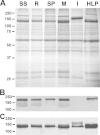Comparative genome sequencing of Rickettsia rickettsii strains that differ in virulence
- PMID: 25644009
- PMCID: PMC4363411
- DOI: 10.1128/IAI.03140-14
Comparative genome sequencing of Rickettsia rickettsii strains that differ in virulence
Abstract
Rickettsia rickettsii is an obligate intracellular pathogen that is the causative agent of Rocky Mountain spotted fever. Strains of R. rickettsii differ dramatically in virulence. In a guinea pig model of infection, the severity of disease as assessed by fever response varies from the most virulent, Sheila Smith, to Iowa, which causes no fever. To identify potential determinants of virulence in R. rickettsii, the genomes of two additional strains were sequenced for comparison to known sequences (comparative genome sequencing [CGS]). R. rickettsii Morgan and R strains were compared to the avirulent R. rickettsii Iowa and virulent R. rickettsii Sheila Smith strains. The Montana strains Sheila Smith and R were found to be highly similar while the eastern strains Iowa and Morgan were most similar to each other. A major surface antigen, rickettsial outer membrane protein A (rOmpA), is severely truncated in the Iowa strain. The region of ompA containing 13 tandem repeats was sequenced, revealing only seven shared SNPs (four nonsynonymous) for R and Morgan strains compared to Sheila Smith, with an additional 17 SNPs identified in Morgan. Another major surface antigen and autotransporter, rOmpB, exhibits a defect in processing in the Iowa strain such that the beta fragment is not cleaved. Sequence analysis of ompB reveals identical sequences between Iowa and Morgan strains and between the R and Sheila Smith strains. The number of SNPs and insertions/deletions between sequences of the two Montana strains and the two eastern strains is low, thus narrowing the field of possible virulence factors.
Copyright © 2015, American Society for Microbiology. All Rights Reserved.
Figures





Similar articles
-
Genomic comparison of virulent Rickettsia rickettsii Sheila Smith and avirulent Rickettsia rickettsii Iowa.Infect Immun. 2008 Feb;76(2):542-50. doi: 10.1128/IAI.00952-07. Epub 2007 Nov 19. Infect Immun. 2008. PMID: 18025092 Free PMC article.
-
Targeted knockout of the Rickettsia rickettsii OmpA surface antigen does not diminish virulence in a mammalian model system.mBio. 2015 Mar 31;6(2):e00323-15. doi: 10.1128/mBio.00323-15. mBio. 2015. PMID: 25827414 Free PMC article.
-
The Rickettsial Ankyrin Repeat Protein 2 Is a Type IV Secreted Effector That Associates with the Endoplasmic Reticulum.mBio. 2018 Jun 26;9(3):e00975-18. doi: 10.1128/mBio.00975-18. mBio. 2018. PMID: 29946049 Free PMC article.
-
Rickettsia rickettsii virulence determinants RARP2 and RapL mitigate IFN-β signaling in primary human dermal microvascular endothelial cells.mBio. 2024 Apr 10;15(4):e0345023. doi: 10.1128/mbio.03450-23. Epub 2024 Mar 6. mBio. 2024. PMID: 38445878 Free PMC article.
-
Proteolytic Cleavage of the Immunodominant Outer Membrane Protein rOmpA in Rickettsia rickettsii.J Bacteriol. 2017 Feb 28;199(6):e00826-16. doi: 10.1128/JB.00826-16. Print 2017 Mar 15. J Bacteriol. 2017. PMID: 28031280 Free PMC article.
Cited by
-
Rickettsia amblyommatis in Ticks: A Review of Distribution, Pathogenicity, and Diversity.Microorganisms. 2023 Feb 16;11(2):493. doi: 10.3390/microorganisms11020493. Microorganisms. 2023. PMID: 36838458 Free PMC article. Review.
-
Isolate-Dependent Differences in Clinical, Pathological, and Transcriptional Profiles following In Vitro and In Vivo Infections with Rickettsia rickettsii.Infect Immun. 2021 Mar 17;89(4):e00626-20. doi: 10.1128/IAI.00626-20. Print 2021 Mar 17. Infect Immun. 2021. PMID: 33495273 Free PMC article.
-
Identification of an autotransporter peptidase of Rickettsia rickettsii responsible for maturation of surface exposed autotransporters.PLoS Pathog. 2023 Jul 31;19(7):e1011527. doi: 10.1371/journal.ppat.1011527. eCollection 2023 Jul. PLoS Pathog. 2023. PMID: 37523399 Free PMC article.
-
Endothelial Mechanistic Target of Rapamycin Activation with Different Strains of R. rickettsii: Possible Role in Rickettsial Pathogenesis.Microorganisms. 2024 Jan 30;12(2):296. doi: 10.3390/microorganisms12020296. Microorganisms. 2024. PMID: 38399700 Free PMC article.
-
Comparative Analysis of Infection by Rickettsia rickettsii Sheila Smith and Taiaçu Strains in a Murine Model.Pathogens. 2020 Sep 10;9(9):744. doi: 10.3390/pathogens9090744. Pathogens. 2020. PMID: 32927666 Free PMC article.
References
-
- Ricketts HT. 1909. Some aspects of Rocky Mountain spotted fever as shown by recent investigation. Med Rec 76:843–855. - PubMed
-
- Dyer RE. 1931. Rocky Mountain spotted fever (Eastern type): transmission by the American dog tick (Dermacentor variabilis). Public Health Rep 46:1403–1412. doi:10.2307/4580068. - DOI
-
- Lillie RD. 1931. Pathology of the Eastern type of Rocky Mountain spotted fever. Public Health Rep 46:2840–2859. doi:10.2307/4580261. - DOI
Publication types
MeSH terms
Substances
Grants and funding
LinkOut - more resources
Full Text Sources
Molecular Biology Databases

